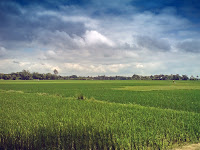 The Food and Agriculture Organisation
(FAO) says millions of people could escape poverty, hunger and
environmental degradation if countries put more effort into promoting
agro-forestry, an integrated approach combining trees with crop or
livestock production.
The Food and Agriculture Organisation
(FAO) says millions of people could escape poverty, hunger and
environmental degradation if countries put more effort into promoting
agro-forestry, an integrated approach combining trees with crop or
livestock production.The agro-forestry sector is a significant source both of local commodities such as fuel wood, timber, fruit and fodder for livestock as well as global ones such as coconut, coffee, tea, rubber and gum.
Agricultural Investments News
Almost half the world's agricultural
land has at least 10 per cent tree cover, making agro-forestry critical
to the livelihoods of millions.
This is according to the FAO’s new guide published this month, which was made available to the Ghana News Agency yesterday.
It aims at decision-makers, key policy advisor's, NGOs and governmental institutions. The FAO shows how agro-forestry can be integrated into national strategies and how policies can be adjusted to specific conditions.
The organisation’s policy guide provides examples of best practices and success stories, as well as lessons learned from challenges and failures.
It said new opportunities provided by agro-forestry were emerging, for example, within the miombo woodlands of central, eastern and southern Africa, which cover three million square kilometers over 11 countries and contribute significantly to the livelihoods of some 100 million low-income people.
The FAO said among these new opportunities was the potential to curb greenhouse gas emissions by slowing forest conversion to farmland and to sequester carbon in trees on farms, as a result of the financial incentives offered by carbon trade and the REDD+ initiative.
Similarly, it said, the expansion of natural regeneration of over five million hectares of dry degraded land in Niger would contribute to mitigating climate change and increase rural income.
The guide provides ten major tracks for policy action, including: raising awareness of agroforestry systems to farmers and the global community; reforming unfavourable regulations in forestry, agricultural and rural codes; and clarifying land-use policy regulations.
The organisation said the latter did not necessarily mean formal land titling. Research has found that some customary forms of tenure provide the security to plant trees, while reducing the formalities and costs of administration.
The FAO guide said farmers introducing trees on farms should be rewarded for the ecosystem services they provided to society through financial or other incentives in the form of grants, tax exemptions, cost sharing programmes, microcredits or delivery in kind, especially extension services and infrastructure development, according to the guide.
It said long-term credit was also crucial, as benefits to farmers planting trees reached them only after some years.
The
FAO said the value of carbon sequestered and other environmental
services provided by the trees could even be applied to paying the
interest.
It said in Costa Rica, a national forestry financing fund assigned in 1996 by law to subsidise forestry activities was extended in 2001 and 2005 to agro-forestry systems combining crops, trees and cattle.
It said over the last eight years, more than 10,000 contracts had been signed for agro-forestry, which resulted in planting of more than 3.5 million trees on farms.
The guide was developed by FAO in cooperation with the World Agro-forestry Centre, the Tropical Agricultural Research and Higher Education Centre and the Agricultural Research Centre for International Development.
It said in Costa Rica, a national forestry financing fund assigned in 1996 by law to subsidise forestry activities was extended in 2001 and 2005 to agro-forestry systems combining crops, trees and cattle.
It said over the last eight years, more than 10,000 contracts had been signed for agro-forestry, which resulted in planting of more than 3.5 million trees on farms.
The guide was developed by FAO in cooperation with the World Agro-forestry Centre, the Tropical Agricultural Research and Higher Education Centre and the Agricultural Research Centre for International Development.
The article was reproduced as it appeared in Government of Ghana Official website.
Agricultural Investments with Growth Green Agriculture
+Growth Green Agriculture Plc is a UK based agricultural investments company specialising in emerging markets offering lucrative opportunities to invest in Ghana. Growth Green Agriculture acts as consultant on green and socially responsible investments to the private and institutional investor community in Europe.
Visit us today and find out more about this exciting opportunity http://ggagriculture.com

